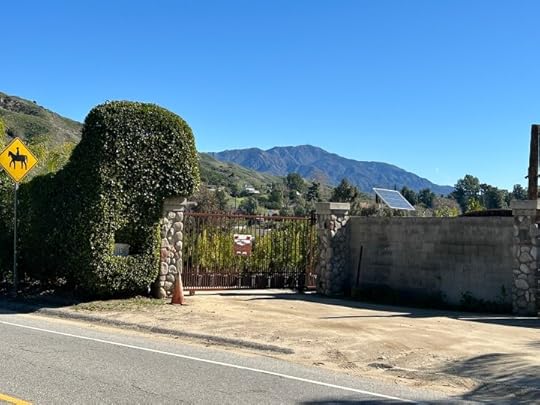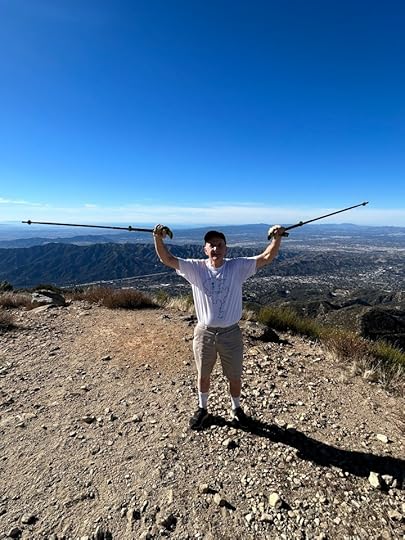It is all downhill from here.
Los Angeles is the tallest city in the United States, measuring in elevation from sea level along the coast at Pacific Palisades, Venice, and San Pedro to 5075 feet high at the top of Mt. Lukens. The peak is in the far northeast corner of the San Fernando Valley and just barely inside the LA City limits. You could almost kick a rock off the top into Angeles National Forest.

Mt Lukens’ profile is far from iconic, only rarely snow covered, and whatever natural beauty it might have is marred by an array of communication towers that dominate the summit. It does not get much respect. Most Angelenos have never heard of it. Nonetheless, it seemed like the logical place to begin my walk around the Los Angeles city limits–a counterclockwise, 342-mile ziggy loop.
My first five miles, however, didn’t count, because that was the distance from the trailhead at the edge of development up a steep trail through chaparral to the summit. Canyons and ridges dropped away with breathtaking steepness in multiple directions, and looking toward “civilization,” the first signs of humans were vast areas of concrete pavement lining the outlets of the largest canyons. These are “catchment basins” designed to protect the adjacent residential neighborhoods from torrents of muddy water and debris that threaten the area during the rainy season. Looking farther in the distance, downtown LA was silhouetted to the east and in the far distance, about 35 miles away, the skyline of downtown Long Beach, just outside the LA City limits, was contrasted against the shimmering Pacific Ocean. Twenty-five miles beyond that, Catalina Island’s outline was faintly visible. It was a spectacular panorama, which, for a moment, dissolved my trepidations about the jaunt.

My hiking buddy, Thomas, and I took pictures of each other with the city in the background and then started walking the line—about six miles via another slightly less steep trail back to civilization. There were other trails that wandered off in several directions, none of them were marked with more than a steel post, some not at all. Thomas, a more experienced hiker of the California wilderness than I, was comfortable with such limited directional guidance, and with the assistance of the AllTrails smartphone app, we made it down with only several wrong turns, which AllTrails quickly alerted us to. It was good that he had downloaded the app and map, because even with civilization visible in the distance and with multiple communication towers looming above us, cell phone service was spotty at best.
Portions of our path down were on fire roads suitable for four-wheel drive vehicles, and we met a few intrepid mountain bikers and several hikers, some with their dogs. Other portions were narrow tracks with vegetation so close that it snagged our hiking poles with every swing. The worst part, however, was the multitude of fist-sized rocks that seemed to be annoyingly located anywhere I might want to plant my foot. Try to step around them or balance on top of them? I don’t remember which I was trying to do when I fell sideways across my trekking pole, breaking its aluminum shaft. But maybe it broke my fall sufficiently that I ended up with only a few knee and elbow scuffs. (Later at home I resorted on my orthopedic skills to repair the broken pole. It no longer collapses for transit and storage, but it is as stout and supportive as before.) Five miles down, 337 to go. The panorama from the top sticks in my mind—a good way to start an adventure.
For the next several days, however, I was sore, not from the fall, but from delayed onset muscle soreness in my calves. Despite having trained beforehand on some seriously steep trails and streets in my neighborhood, my calves were still not conditioned for the nearly 3000-foot descent from summit to trailhead. Some people toss around the acronym DOMS when discussing delayed onset muscle soreness as if that makes them sound knowledgeable. They aren’t. Nobody is. I will put my orthopedic-surgeon hat on for a minute.
A buildup of lactic acid is a frequently implicated culprit; and muscle contractions do produce lactic acid, but it is metabolized in an hour. DOMS typically does not develop for another day or two. It most frequently occurs when a muscle repeatedly gets longer rather than shorter while it is contracting, which may sound confusing. Consider, for instance, performing an elbow curl while holding a dumbbell. Your biceps contracts, and the dumbbell comes up to your shoulder. Now lower the weight slowly. The biceps is still firing, but it is getting longer as it allows the elbow to slowly straighten. The calf muscles do the same thing with downhill walking. Not only is the cause of DOMS unclear, so is the best treatment. Anecdotal advice abounds regarding the purported benefit of ice, heat, foam rolling massage, light exercise, and herbal preparations. None of the treatments are supported by good science. Time heals all wounds, and once the DOMS-affected muscle recovers, it is resistant to a repeat bout, at least for a while. I will be interested in seeing if I develop DOMS again on the way down from Mt. Lukens after celebrating the end of my trip.
The post It is all downhill from here. appeared first on MuscleAndBone.Info.



